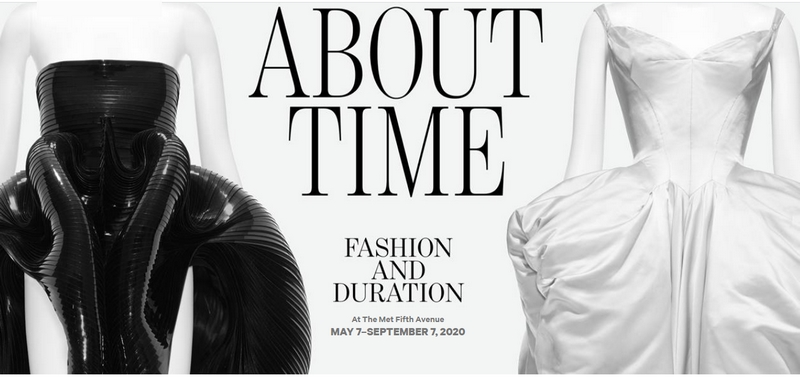The Costume Institute’s spring 2020 exhibition will trace more than a century and a half of fashion—from 1870 to the present—along a disruptive timeline, as part of The Met’s 150th-anniversary celebration. Employing Henri Bergson’s concept of la durée (duration), it will explore how clothes generate temporal associations that conflate past, present, and future. Virginia Woolf will serve as the “ghost narrator” of the exhibition.

About Time: Fashion and Duration exhibition 2020 at The Costume Institute @.metmuseum.
“For what more terrifying revelation can there be than that it is the current moment?” wrote Virginia Woolf in her 1928 time-travelling classic, Orlando. “That we survive the shock at all is only possible because the past shelters us on one side, the future on another.”
These ever-relevant words, and other Woolf passages, would soundtrack the Metropolitan Museum of Art’s next major exhibition, its curator, Andrew Bolton, said at a press launch in Paris on Thursday.
The exhibition – About Time: Fashion and Duration, which opens on 7 May – was conceived to celebrate the New York museum’s 150th anniversary, and will incorporate garments from the institution’s 1870 conception to the present.
Rather than presenting a linear history it will make the case for fashion as something that can distill the current moment while also bending and subverting our concept of time, according to Bolton.
The show’s framework would be the rival “concepts of temporality” espoused by the poet Charles Baudelaire and the philosopher Henri Bergson, said Bolton.
Baudelaire, he said, argued that time, and by extension fashion, was a place of “endless mutability”, continuous and always striving for the new. Bergson challenged this view and “argued that basic sense of temporal succession was an illusion. He contended that time exists as duration, a continuous flow in which thoughts, feelings and memories exist together.”
A video installation of black and white photographs drew parallels between old and new: the reptilian curves of a 3D-printed Iris van Herpen dress from 2012 were juxtaposed with a panniered gown by the American couturier Charles James from 1951. The silhouette of a bell-skirted mid-calf gown from 1919 was echoed by a bulbous 2012 Comme des Garçons midi dress.
Speaking against the spectacular backdrop of the Musée d’Orsay clockface, Bolton said the exhibition would also feature a giant timepiece created by the artist and set designer Es Devlin.
“Fashion’s most distinctive power, one of the most basic, is enabling us to come unstuck from time,” said Bolton. Nicolas Ghesquière, the artistic director of womenswear at Louis Vuitton, argued that clothes were “wearable treasures that can continue to tell their vital stories about who we were, who we are and where we are going”.
Addressing the durability of fashion is a timely subject as the industry grapples with issues around sustainability.
“In recent years time has dominated discussions within the fashion community,” said Bolton. He added that the accelerated production and consumption of the digital era had benefited companies but had left many designers feeling “creatively constrained”.
The impact of the annual Met exhibition will be magnified by the accompanying Met Gala red carpet event – sometimes described as “Halloween for fashion people” – in which celebrities’ outfits will reflect the theme. In previous years, Rihanna has dressed as the pope for an exhibition themed around Catholicism, and Jared Leto carried a replica of his own head as an expression of the theme “camp”.
Fashion’s ability to bend time materialised on the Paris catwalk later on Thursday, in a Chloé show packed with references to the 1970s and a Paco Rabanne collection event at which models wore glam-rock platforms with Victorian ruffs and medieval-style chainmail.
- About Time: Fashion and Duration is at the Metropolitan Museum of Art in New York from 7 May to 7 September.
guardian.co.uk © Guardian News & Media Limited 2010
Published via the Guardian News Feed plugin for WordPress.

